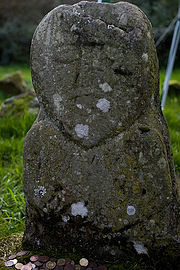User:Ceoil/sandbox
File:Tricephale divinity.png

The Boa Island stone figures

The Caldragh graveyard on Boa Island contains two anthropomorphic carved stone statues known as the Boa Island figure and the Lustymore Island figure.[1] The graveyard dates from the Irish early Christian period (400–800 AD).[2]
Both figures were badly damaged when rediscovered. They have been placed beside each other on unrelated pillars in the graveyard' the original location of the Boa figure.[3] A canopy was placed over them to protect them from the weather, however this has since been removed. Both figures are generally accepted to be the likeness of pagan deities.[2]
Figures
[edit]Janus
[edit]The Janus (two headed) figure is the Boa largest of the Boa sculptures, and is regarded as one of Ireland's most enigmatic and remarkable stone figures.[1] It is thought to represent a Celtic deity and could represent a Celtic goddess as readily as a god, especially given the name of the island. In Celtic mythology, heads were given great importance as they were thought to contain a person's spirit, and severed heads were sometimes taken in triumph after battles.[2]

The Boa Island bilateral figure is 73 cm (29 in) high, 45 cm (18 in) wide on its two broader surfaces, and 30 cm (12 in) wide on its two narrow surfaces.[3] Each side of the figure has a face and torso. On the sides of the stone where the two carved figures are joined, is an interlace design that may represent hair. The faces are large and ovals, with big eyes, straight noses, and half-open mouths with protruding tongues above pointed chins.[citation needed]
The figure has no neck, with its head resting directly on its torso. The torso is a square block with hunched shoulders, crossed arms, and a belt.[2][1] The figure ends just below its waist.[3] The lower section of the figure—two hands with elongated fingers carved in relief—was broken away from the top part at an unknown time in the past. This base was recently discovered half-buried in the ground close to the figure.[1]
A deep indentation of unknown purpose is carved at the top of the bilateral figure; tourists often place small mementoes in it for good luck. Fears of damage from freeze-thaw erosion have motivated authorities to provide a canopy over the statue.[citation needed]
The Nobel Prize winning poet Seamus Heaney celebrated the enigmatic Boa Island bilateral figure's similarity to the Roman deity Janus in his poem "January God".[4][5] The Enniskillen-born poet Francis Harvey published a collection of poems called The Boa Island Janus in 1996.[6] Similar statues appear outside the cave of Crom Cruach in The Secret of Kells.
The Lustymore Idol was discovered in an early Christian graveyard on Lustymore Island,[2][3] located due south of Boa Island in Lower Lough Erne. It was brought to the Caldragh graveyard on Boa Island in 1939.[4] It is placed with its back to the indigenous bilateral figure. Lacking details of the facial features, it is less impressive visually,[1] and is approximately 70 cm (28 in) in height.[3] It is, however, thought to be older than the bilateral 'Janus' figure – which is less worn than the Lustymore figure. Irish archaeologist Eileen Murphy states in Warrior Women (2002) that the Lustymore Idol is thought by some Irish scholars to be the precursor to Sheela na gigs: her arms lie across the torso and point toward the inverted V that represents the top of the vulva (page 204). A Sheela-na-gig is a female figure with enlarged genitals held open by her hands. Note the current offerings to the statue in the photograph above.
The reasons for creating these stone sculptures and the dates of their creation are not certain. They may have been part of pre-Christian religious sites, or they may have been made by early Christians who included older pagan beliefs in their grave sites.[2]
Boa Island's bilateral figure is often compared to another two-faced Holzgerlingen figure, Germany, and the Tandragee Idol in St. Patrick's Church of Ireland Cathedral, Armagh.[3][7]
Dating
[edit]These comparisons suggest that the figure date to the Iron Age. However early Christian sites around Lough Erne are rich in these types of figures.[2] An example is the White Island collection of figures found 3 miles (4.8 km) south-east of Boa Island,[1] which are primitive looking, but date from the early Christian period.[8]
References
[edit]- ^ a b c d e f Cite error: The named reference
Halpinwas invoked but never defined (see the help page). - ^ a b c d e f g Cite error: The named reference
Queenswas invoked but never defined (see the help page). - ^ a b c d e f O'Kelly, Michael J. (1989). Early Ireland: An Introduction to Irish Prehistory. Cambridge University Press. p. 292. ISBN 0-521-33687-2.
- ^ a b Cite error: The named reference
Culturewas invoked but never defined (see the help page). - ^ McKee, Linda (17 April 2007). "Fury over plan to relocate historic statue". Belfast Telegraph. Archived from the original on 22 April 2007. Retrieved 24 November 2007.
- ^ Irish Writers Online. "Francis Harvey". Archived from the original on 21 October 2007. Retrieved 24 November 2007.
- ^ The Chrono Centre, Queen's University Belfast. "The Tanderagee Idol". Archived from the original on 15 September 2008. Retrieved 24 November 2007.
- ^ Herity, Michael; George Eogan (1996). Ireland in Prehistory. Routledge. p. 253. ISBN 0-415-04889-3.
Sources
[edit]- Ó Hogain, Dáithí. "Patronage & Devotion in Ancient Irish Religion". History Ireland, volume 8, no. 4, winter 2000. JSTOR 27724824
- Rynne, Etienn. "Celtic Stone Idols in Ireland". In: Thomas, Charles. The Iron Age in the Irish Sea province: papers given at a C.B.A. conference held at Cardiff, January 3 to 5, 1969. London: Council for British Archaeology, 1972
- Waddell, John. The Prehistoric Archaeology of Ireland. Galway: Galway University Press, 1998. ISBN 978-1-8698-5739-4
- Warner, Richard. "Two pagan idols – remarkable new discoveries". Archaeology Ireland, volume 17, no. 1, 2003



